1lumen selects and reviews products personally. We may earn affiliate commissions through our links, which help support our testing.
Olight Warrior Nano review
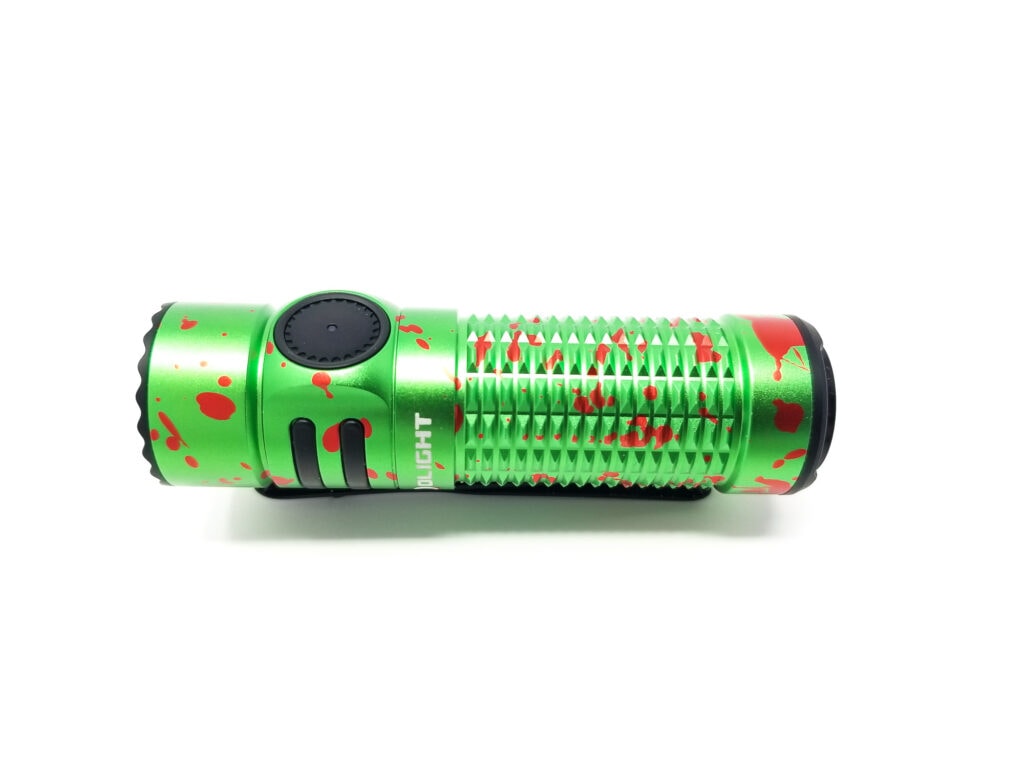
Olight Warrior Nano specs
| Brand & Model | Olight Warrior Nano |
|---|---|
| Flashlight category | Every Day Carry, Small tactical flashlight |
| LED | ? |
| Max. output | 1200 lumens |
| Max. beam distance | 135 meters |
| Max. beam intensity | 4697 cd |
| Battery config. | 1*18350 |
| Onboard charging | Olight MCC |
| Main modes | 6 |
| Blinkies | Strobe |
| Waterproof | IPX8 |
| Review publication date | October 2023 |
Review intro:
If you’ve been into flashlights or hung around flashlight-oriented domains for any amount of time, you’ve probably heard of them. They’re a huge portable lighting device manufacturer based in China, and sell worldwide. 1Lumen has reviewed a ton of their products, and the consensus from our adjudicators (including this one)? They’re great!
Olight is an innovator and proactive with product development and improvement, releasing new products, and new product variations in different colors and materials. Don’t believe me? Go browse their website and have a look-see. Speaking of new products, today I’ve got a new member of the Warrior lineup for review.
The Warrior series are tactical/duty-oriented lights with tail switches and tactical features and UIs. Need a small Warrior? Grab a Warrior Mini. How about a bigger one with lots of beam distance? The Warrior X Turbo would fit the bill. What if a guy or gal wanted something smaller than the Warrior Mini? Well, you were out of luck, but Olight thought of that and released the Olight Warrior Nano. This is a brand-new tactical flashlight and fits between the Baton 3 Pro and Warrior Mini size and output-wise. It’s properly compact, runs an 18350 battery, and packs in all the Warrior goodies. Let’s take a look.
Package quality.
Olight’s packaging is very, very nice. I’ve always enjoyed opening an Olight. It’s a pleasant experience for sure. The Warrior Nano follows the full-size Warrior packaging layout with a 1:1 scale image of the light up front and some specs on the back. Inside it’s neatly arranged. Here’s what you get:
- Olight Warrior Nano
- Olight ORB-183C11: 18350 – 1100 mAh li-ion battery
- MCC charging cable
- Metal L-stand
- Instruction manual
- Safety sheet
This is everything you need to open the light and get going. The battery had an isolator film between the head and driver, so remove that first (the ‘welcome’ deal in the box says so). The battery was sitting at 3.62 volts, so a good storage voltage, but you need to recharge it before use to get the most out of the light. Unfortunately, there were no o-rings in the box. These are wear items, so I hope Olight includes them on production lights. The manual really is multilingual, coming in 20 languages.
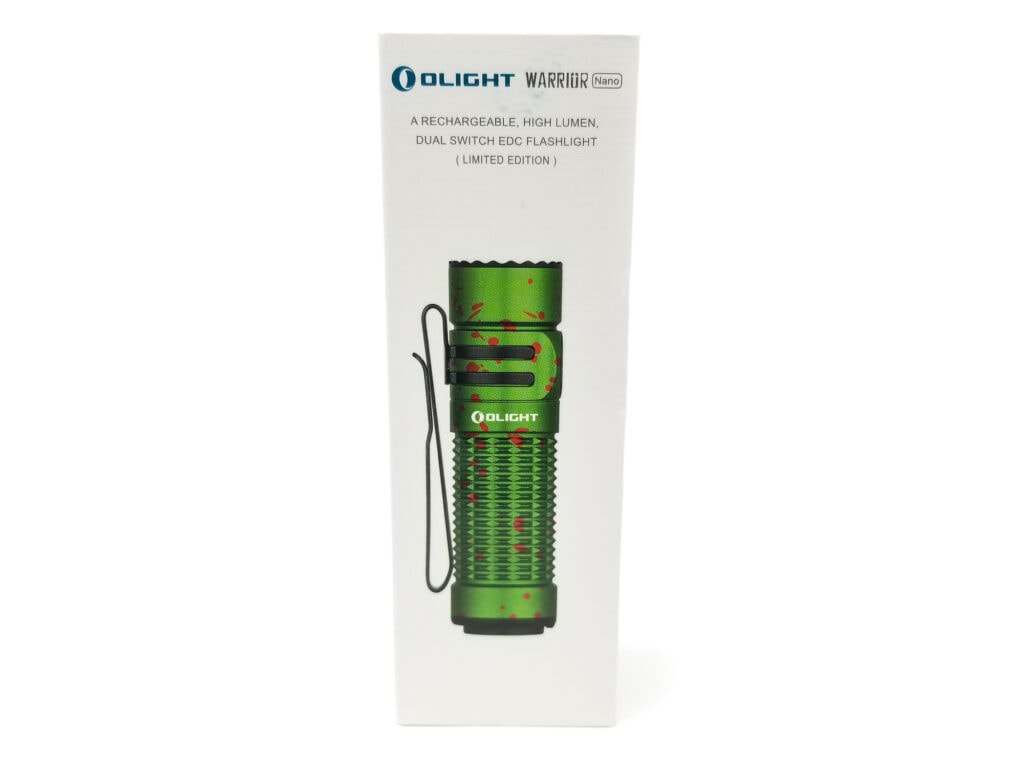
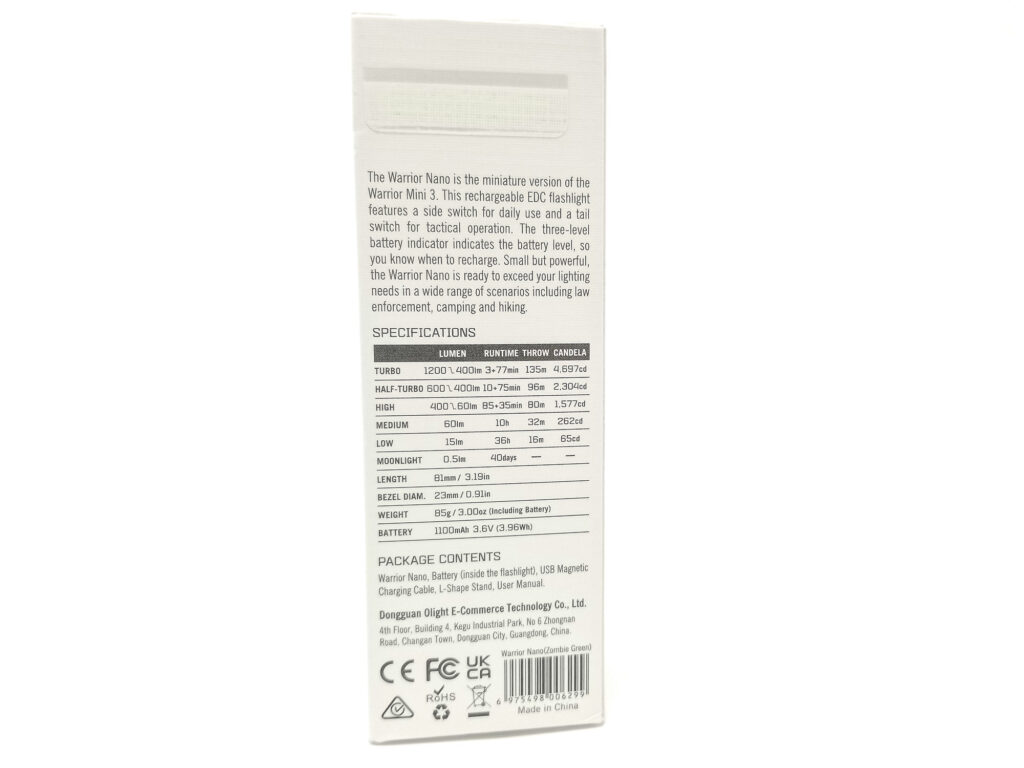
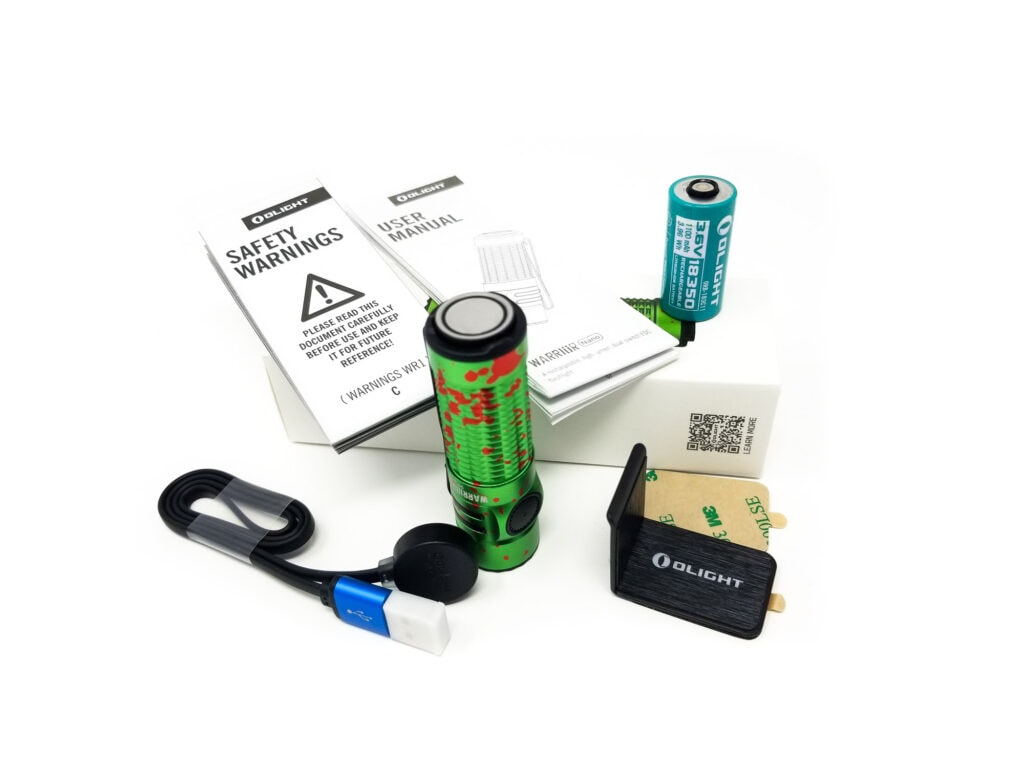
Flashlight in use, Build Quality, and Warranty
The Warrior series are designed as tactical and duty use lights, but they’d be equally at home as general purpose flashlights also. The Warrior Nano fits into a pretty nice niche for use-case, and I feel like it’s more of an EDC type light than an all-out tactical rig. Maybe you could use it as a backup? It’s small, lightweight, and is very nice to pocket.
Handling is really great also because the tube has the aggressive grooves and ridges from the Warrior 3S. This is truly a ‘palmable’ flashlight, and disappeared in my hand. There’s a stainless 2-position deep carry pocket clip that allows for bezel up or down carry or use. It’s removable, and has a unique dual retention clip. I enjoyed toting the Nano around.
There’s a tail switch out back paired with a side switch behind the head. The tail switch is metal, very flat, and magnetic to accommodate the MCC charger, but also has enough magnetic stick to hold the light to any magnetic surface at 90 degrees. In fact, Olight includes a handy metal L-holder that you can stick the light to. It attaches to surfaces with a sticky tape backing.
Uses? It could be used as a hands-free mount I suppose. Olight didn’t need to do this, but they did, so kudos for that. The front e-switch sits very flat to the body, but is easy to find by feel. The boot is a semi-soft rubber, and is easy to manipulate with decent (could be a bit snappier) click action. The rear switch is a 2-position affair for instant half-turbo or strobe. It sits pretty flush to the tailcap, so tail standing is possible and accidental activations were not an issue.
The build quality is great, as I expected. Every Olight I’ve ever reviewed has been top-notch in build quality, design, fit, and finish. The Warrior Nano is no exception. What will a ‘Nano set you back? Expect to pay around $60 US for this one, which isn’t cheap, but I wouldn’t call it expensive either. There’s no quality control concerns to be found. The machining is flawless with no awry tool marks, and all the parts are fit up precisely. There’s no sharp edges anywhere which is important in a pocket light.
The semi-matte anodization is type III HA, and I’d bet Olight gets close to the true MIL-STD HA thickness. You get two color options: Black and a special, 6000-unit limited edition (for Halloween, no less) ‘Zombie Green’ with a green background speckled with red ‘blood’ spots. The review light came in the latter, and it’s…different (I like different).
The Warrior Nano gets an IPX8 rating for ingress protection, and 1.5 meter drop rating. The light is pretty well sealed with o-rings, so I believe the rating. There’s only threads on the front of the tube, and batteries load from the front. The threads are rectangular cut and I’d say adequately sized and really smooth with a good amount of lube.
The head has a unique electrical path with a raised gold-plated contact and internal coil spring for the positive and negative connections. The tail has a spring-loaded contact consisting of 5 contact pads for the tail switch functions and charging interface electrical path.
For the warranty, Olight’s is one of the best in the industry, with a no-hassle 30-day free return policy, and a true lifetime warranty for flashlights and knives. Lifetime means lifetime, and there’s no 5-year limit like before. The new warranty covers the LED, internal batteries, or lenses. Removable batteries are warranted for 2 years, cables, clips, mounts, and remote switches for 1 year.
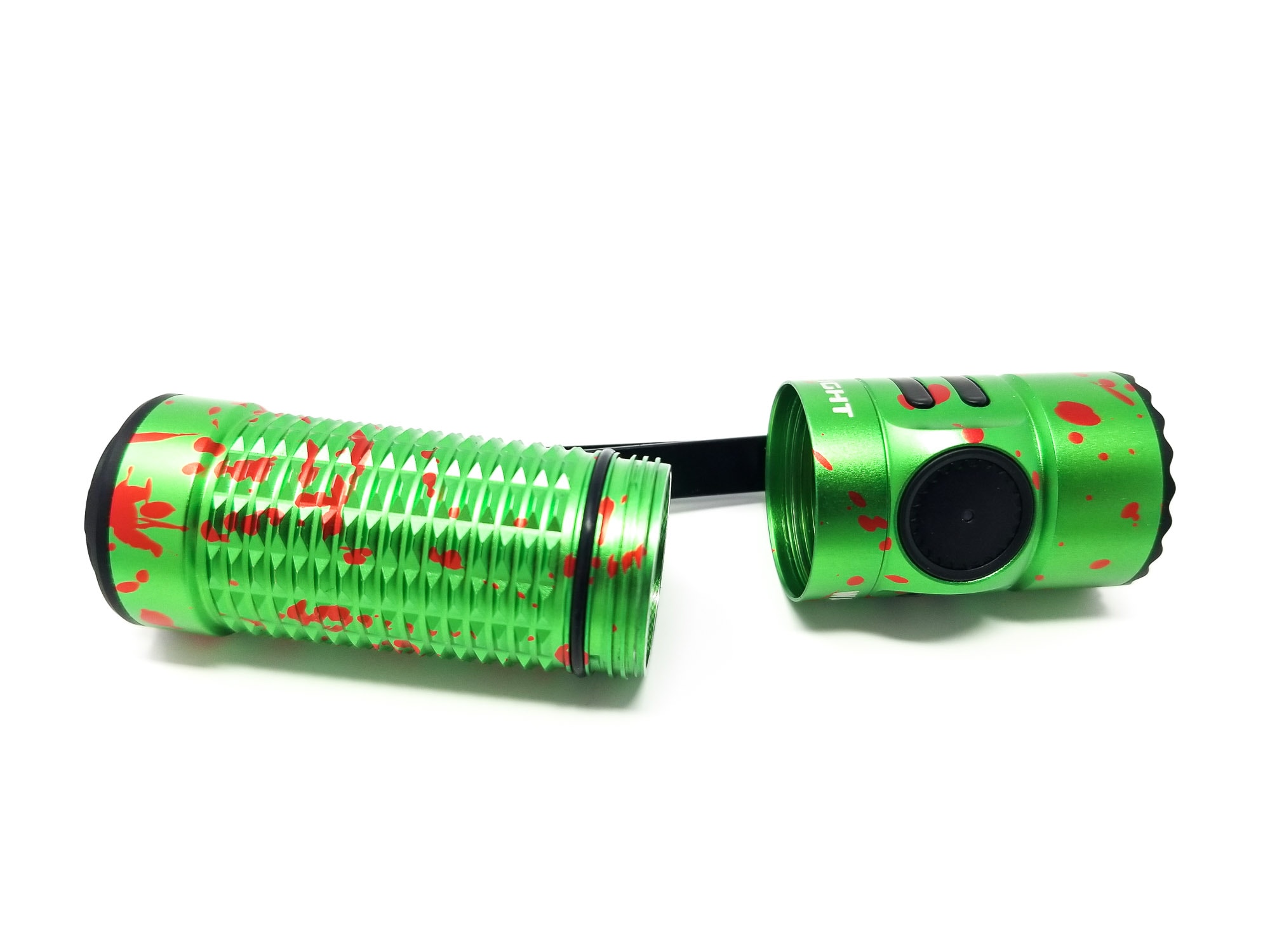
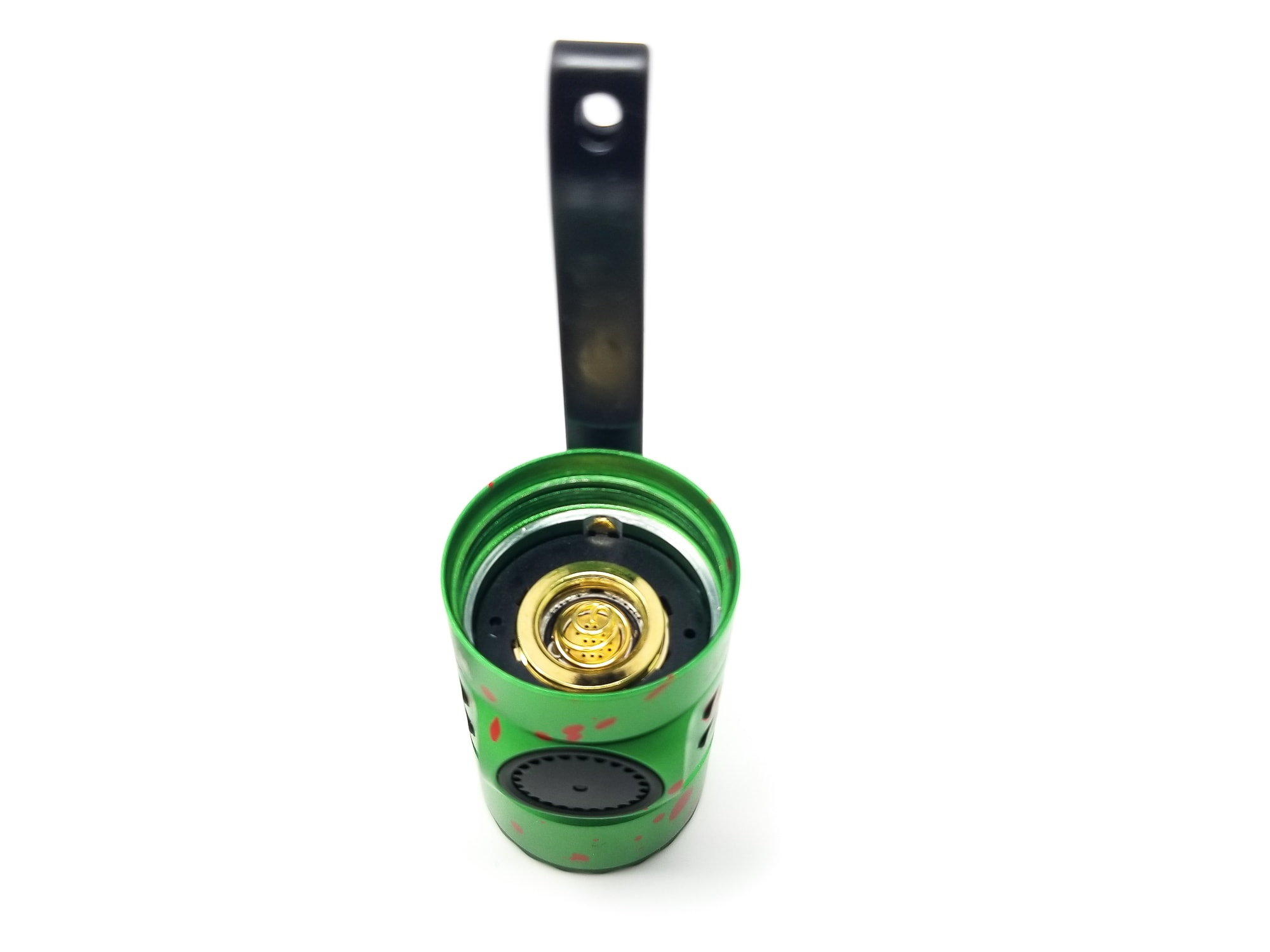
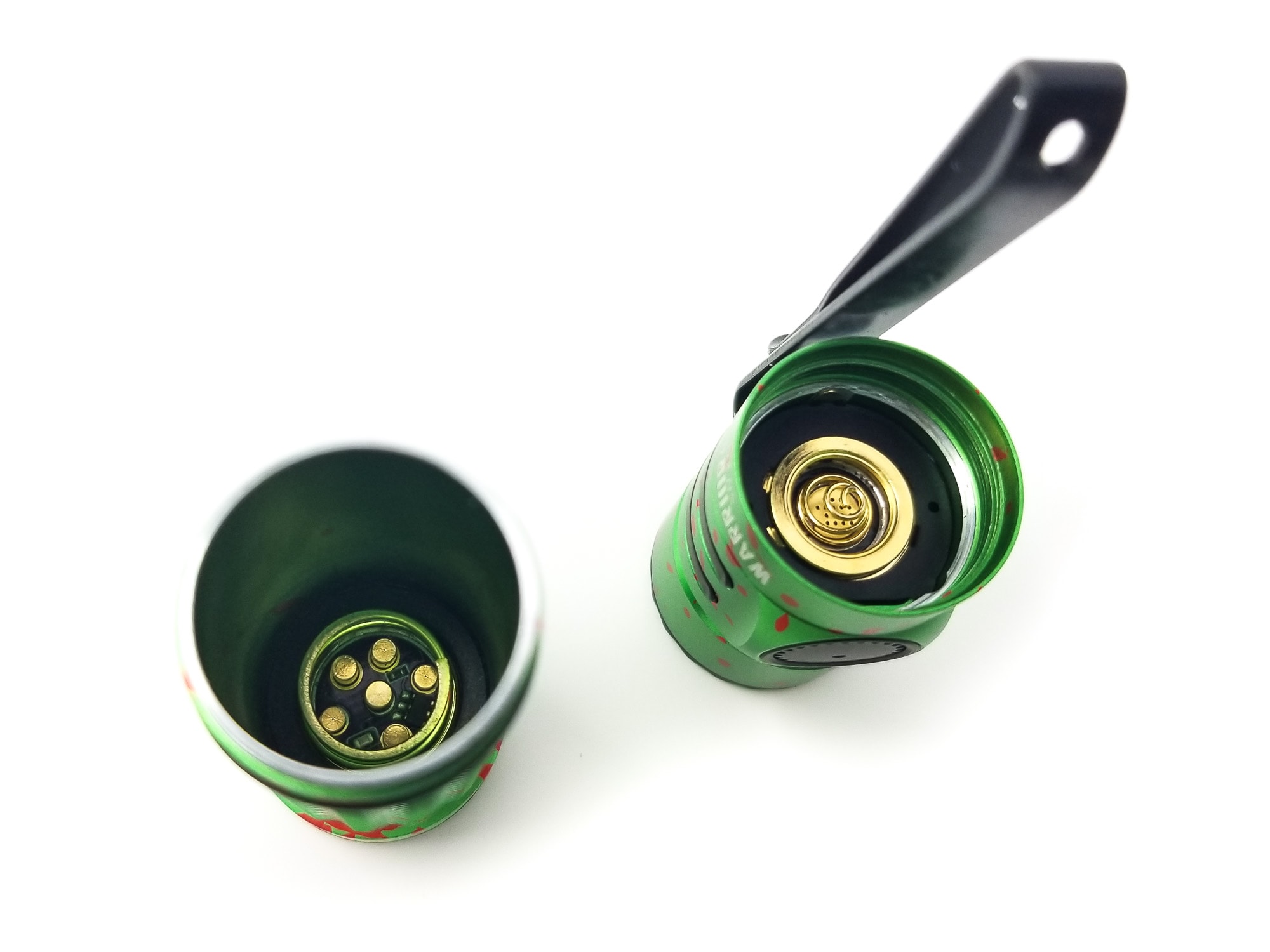
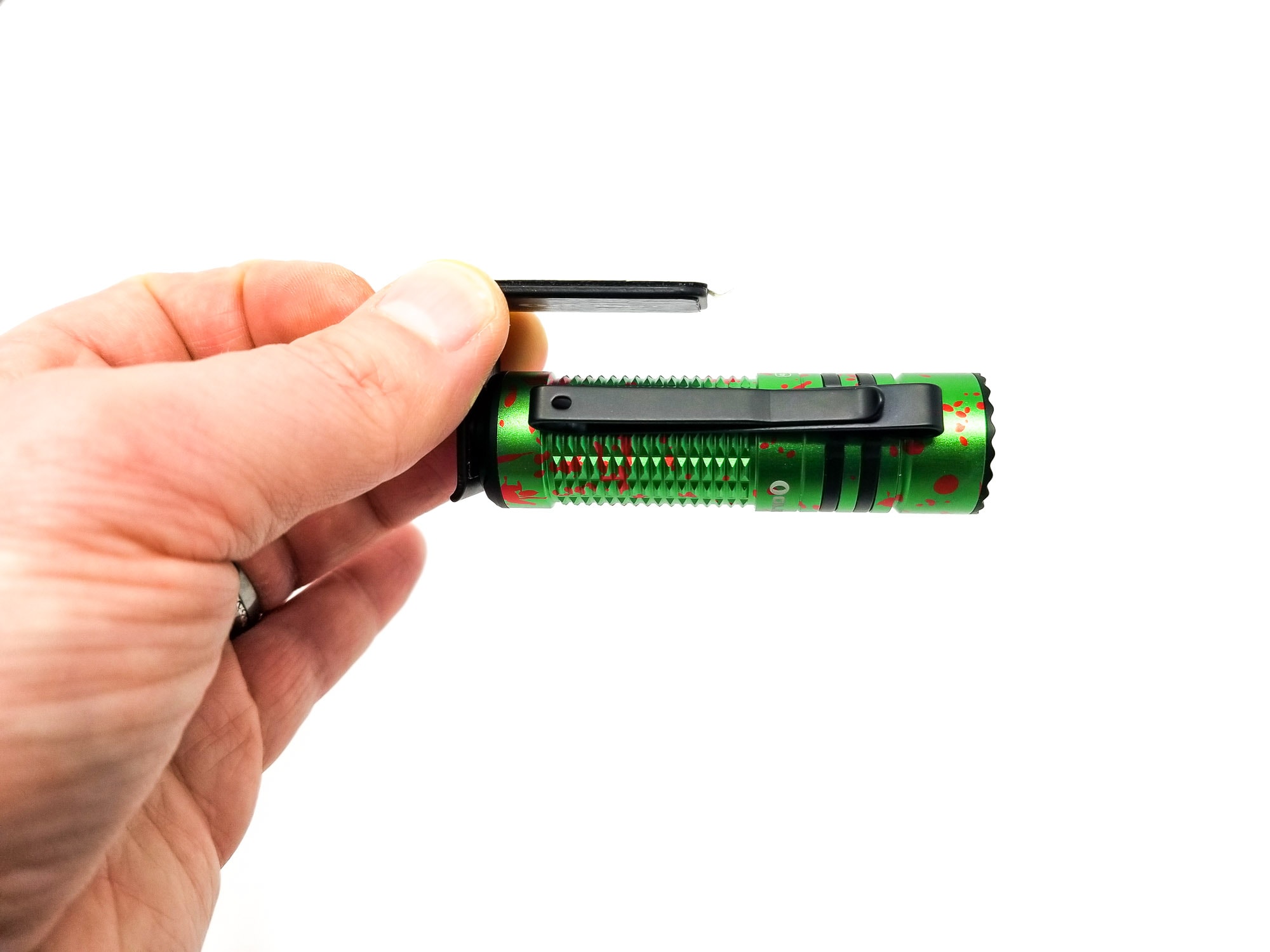
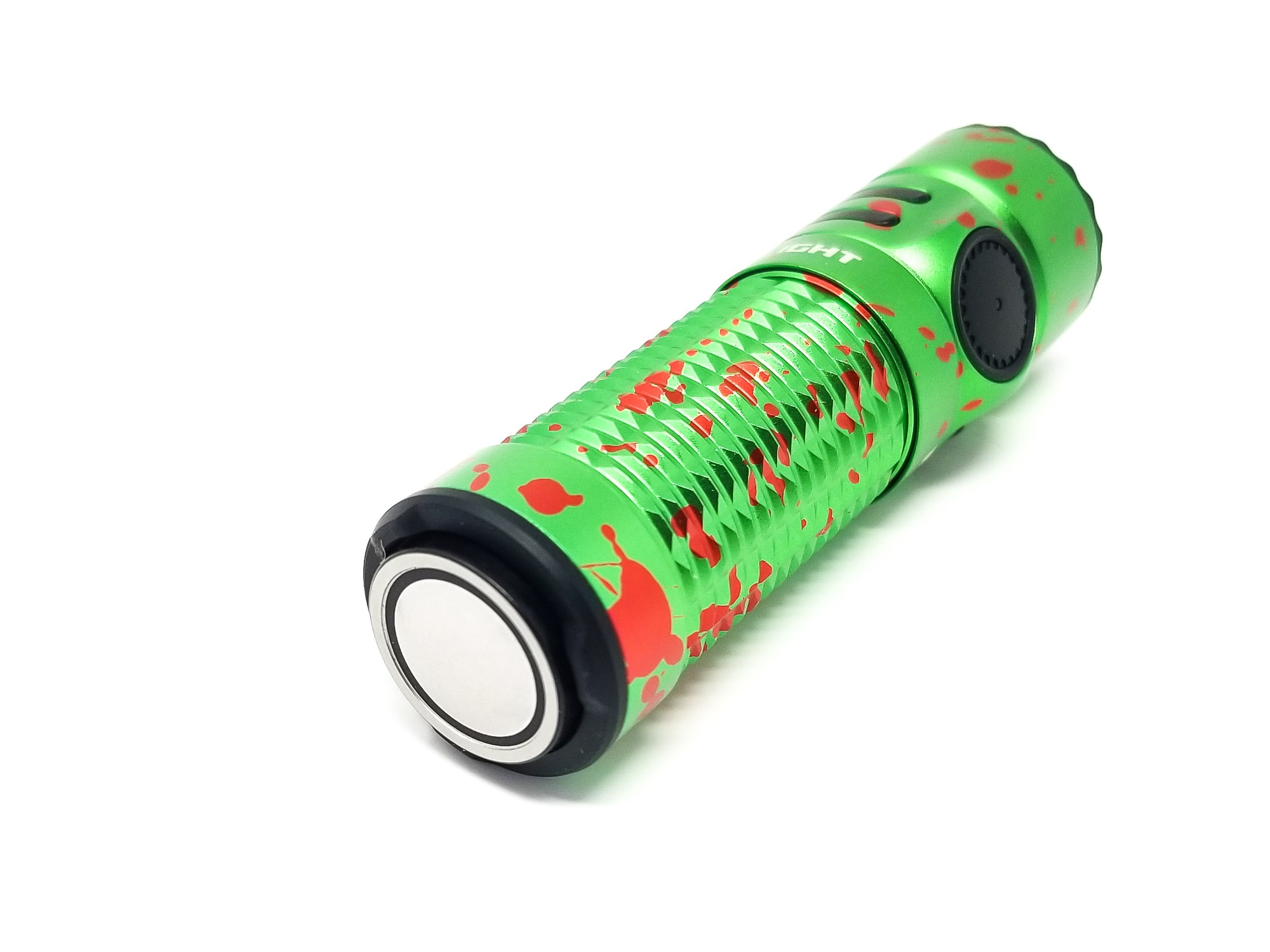

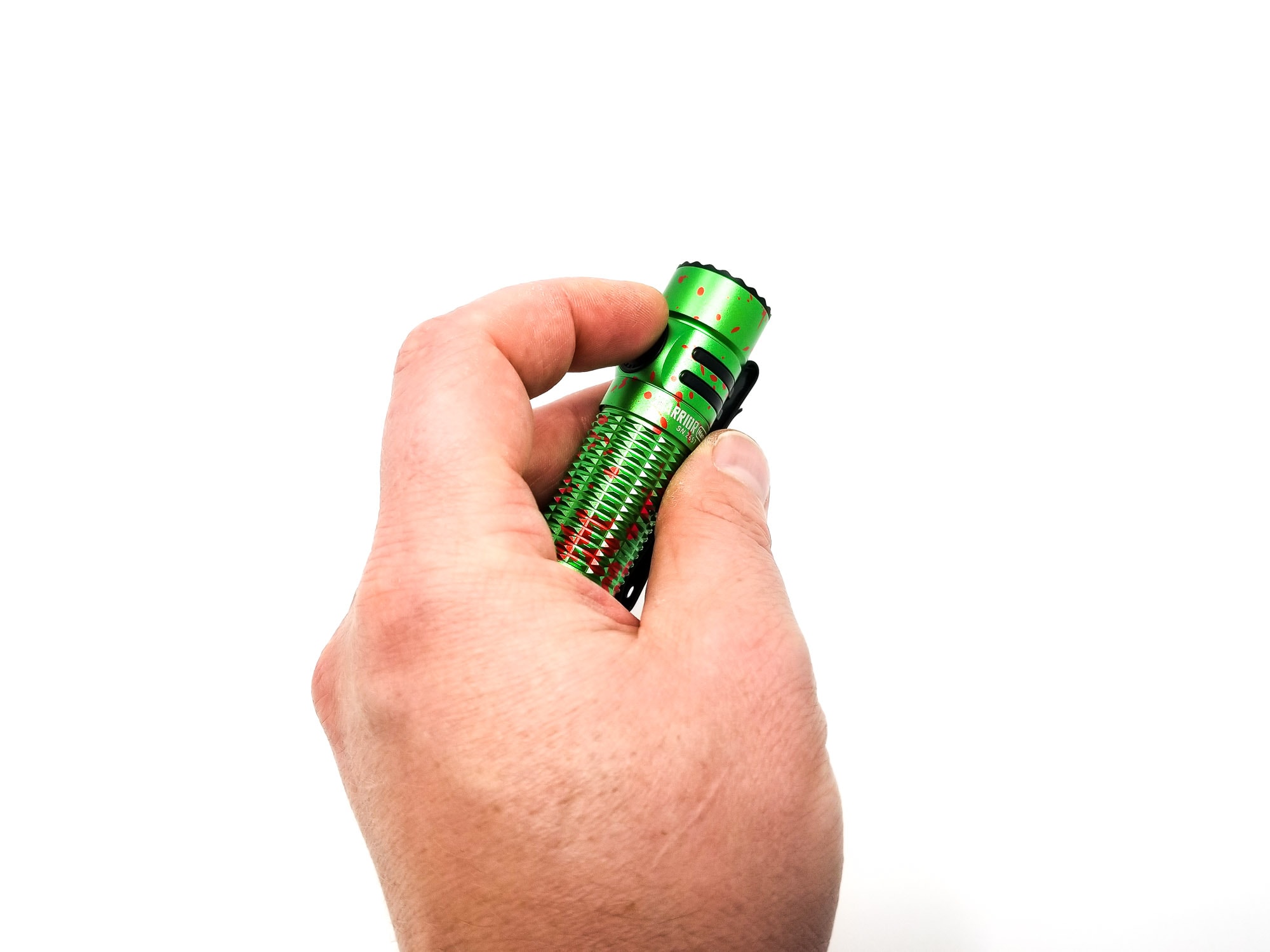
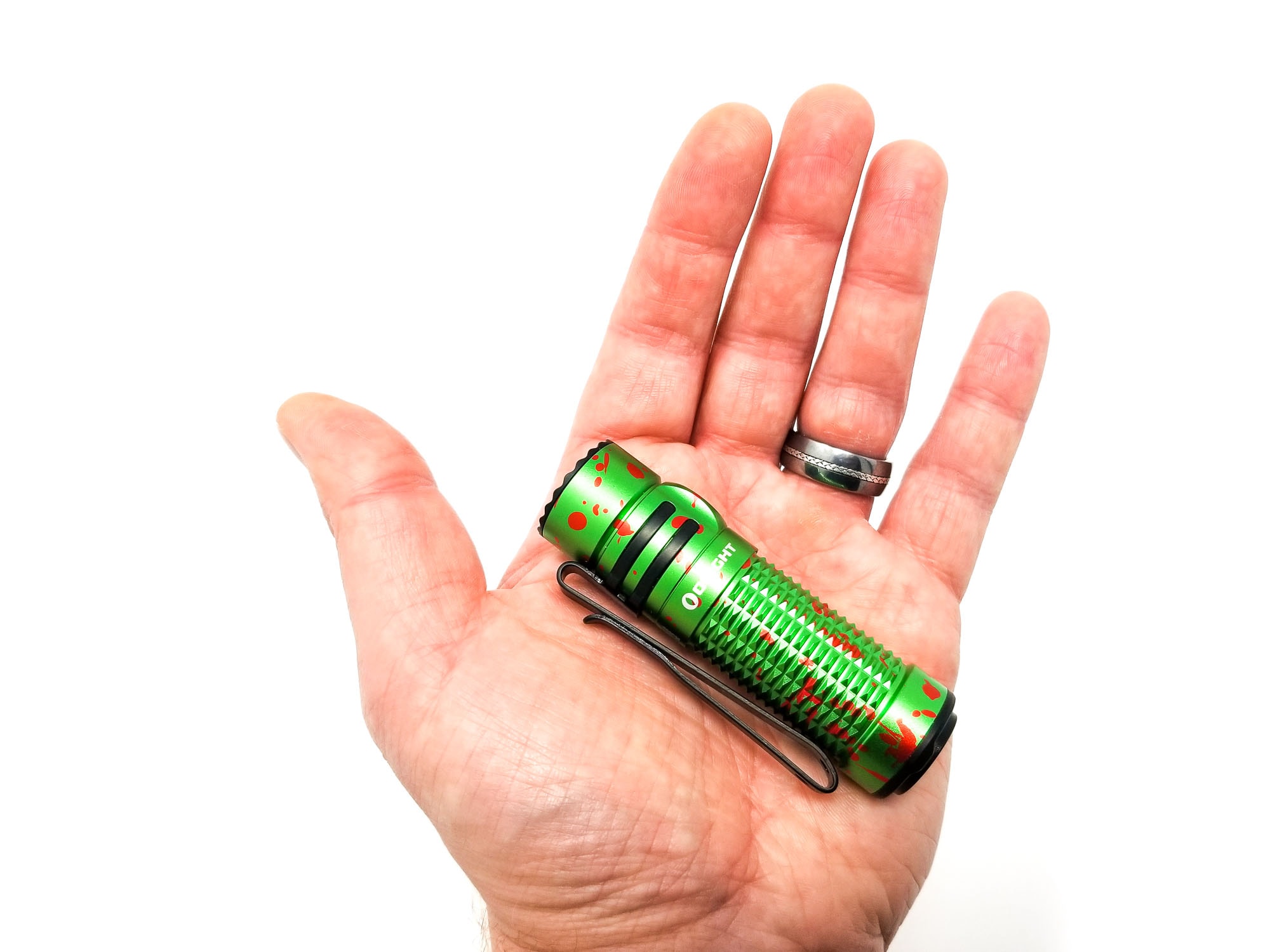
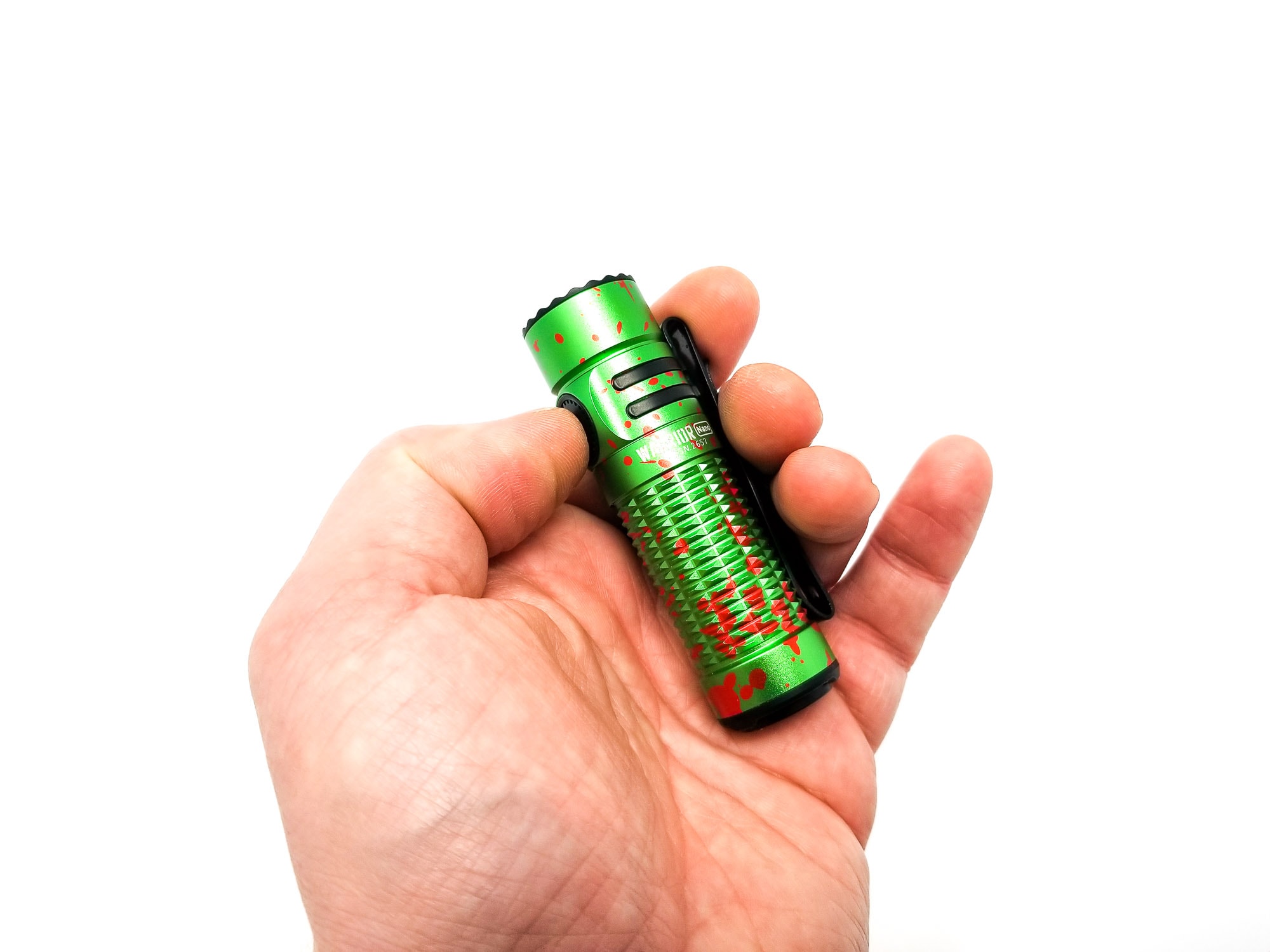
LED, Lens, Bezel, Beam, and Reflector
Olight likes keeping their LED choices a mystery so I can’t tell you exactly what LED the Warrior Nano has, but it looks like a Cree XP-G4 or XP-G3. It’s cool white, as expected, with Olight specifying 5700-6700K and even a 70 CRI spec. The LED sits under a familiar custom hybrid TIR optic that’s a mix of a reflector and TIR. The LED is visible in the center and it works well. The bezel is a crenelated strike bezel with short teeth, but it extends out a ways over the TIR to protect it. It was a nice PVD coated black color on the test light. The beam is pretty clean, and I think great for general purpose use with a large bright circular area with good side illumination.
Spectral measurements:
I used the Opple Lightmaster Pro to measure the flashlight indoors at 1 meters distance.
| Mode: | CCT: | CRI Ra: | duv |
|---|---|---|---|
| Turbo | 7006K | 72.4 | 0.0011 |

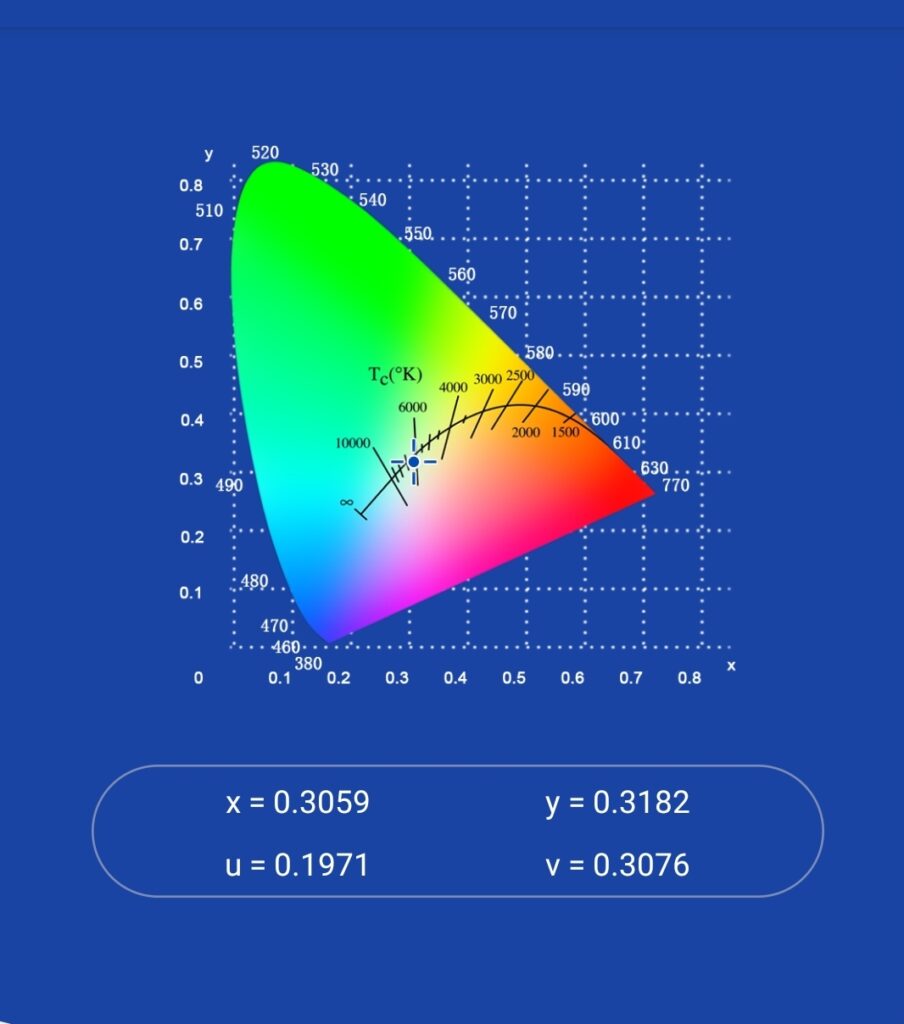
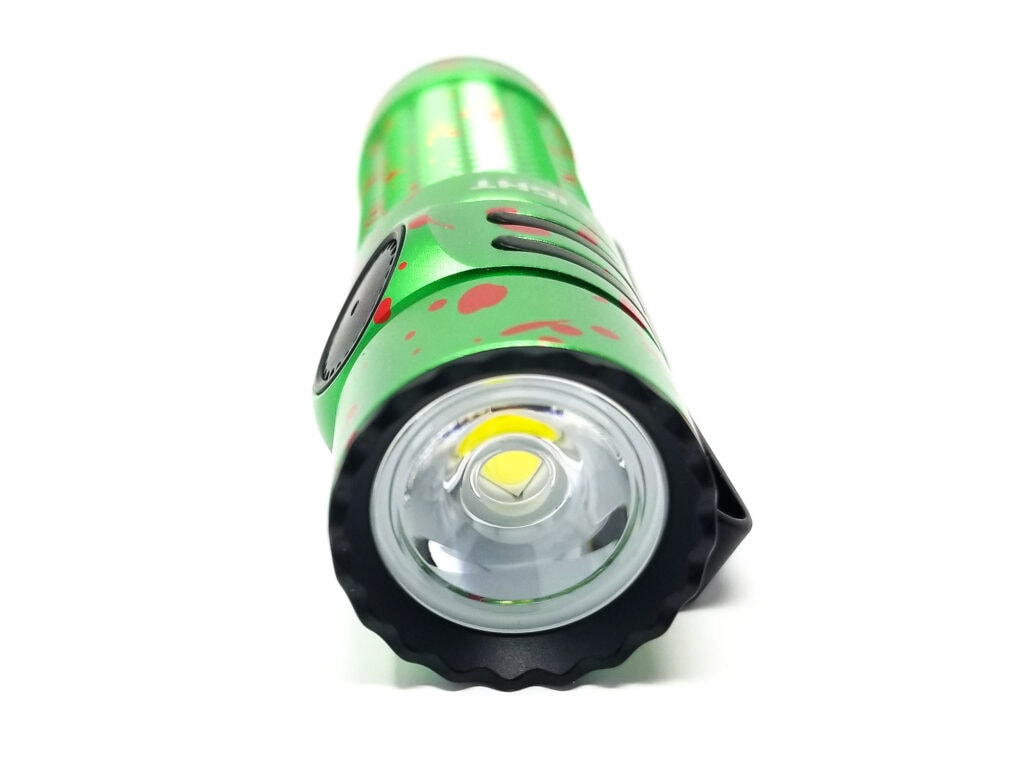
Dimensions and its competition
Dimensions:
| Olight Warrior Nano | Millimeters | Inches |
|---|---|---|
| Length | 81 mm | 3.2 in |
| Head diameter | 23 mm | 0.9 in |
| Body diameter | 23 mm | 0.9 in |
Dimensions are rounded to the nearest millimeter, and to the nearest tenth of an Inch.
Weight:
| Olight Warrior Nano | Weight in grams | Weight in oz |
|---|---|---|
| Without battery: | 60 g | 2 oz |
| With battery | 86 g | 3 oz |
Weight is rounded to the nearest gram, and to the nearest tenth of an Oz.
Flashlight size comparison with its competition:
Group 1 18350 size lights left to right: Loop Gear SK01S LED, Olight Warrior Nano, Manker E14 IV, Manker MC13 II SE
Group 2 left to right: Olight Warrior 3S SE, Olight Warrior Nano, Olight Odin Mini, Olight i3T EOS, Olight i3E EOS Halloween Edition
Group 3 top to bottom: Brinyte HL16, Sofirn SP10 V3, Olight Warrior Nano

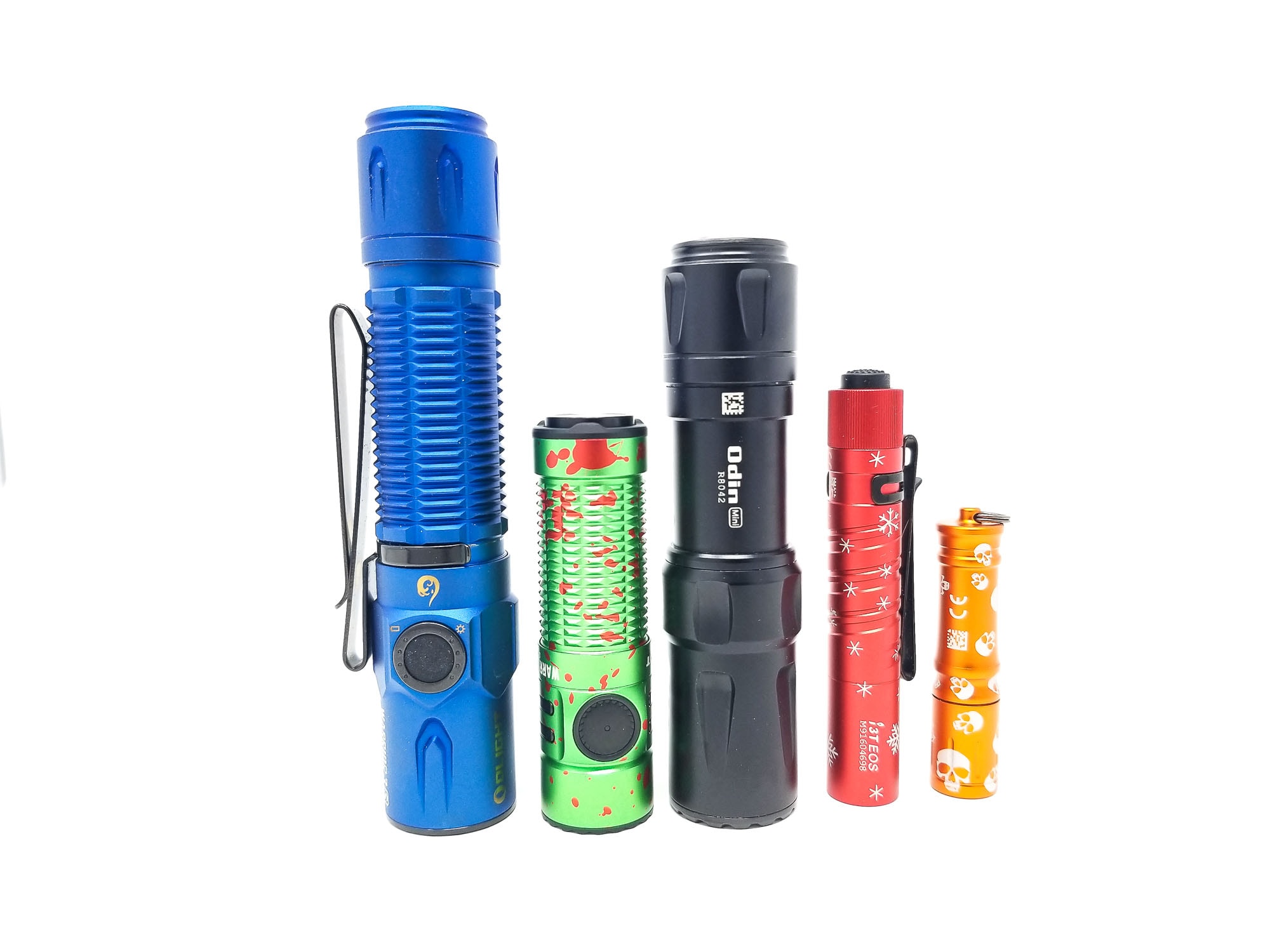
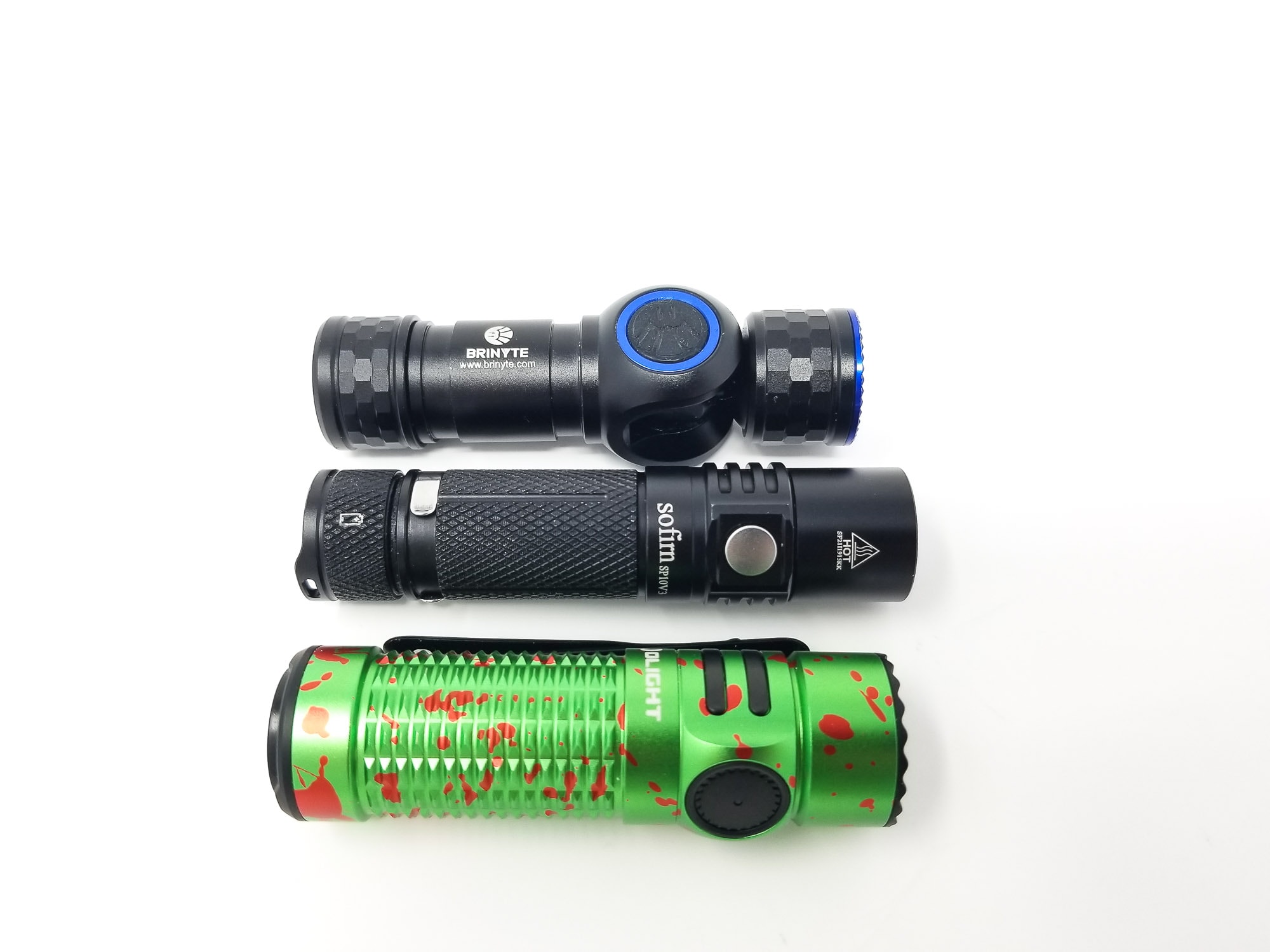
Olight Warrior Nano UI: User Interface and Driver
Olight’s drivers are usually constant current fully regulated units, but the runtimes will prove which one the Warrior Nano has. The UI is typical of Olight’s Warrior series, with the side switch controlling the main modes and the tail switch handling the Half-Turbo, Turbo, and strobe modes. The rear switch is configured like Olight’s other rear switch Warrior lights with momentary/constant-on based on how the switch is pressed. It can also be configured 3 different ways, with the default configuration (configuration 1) being Medium and Half-Turbo, but there’s a second configuration for instant Strobe, and an alternate configuration for Medium/Turbo functionality.
Available modes:
- Moonlight, Low, Medium, High, Half-Turbo, Turbo (Half-Turbo is only available using the tail switch, along with Medium)
Available blinky modes:
- Strobe
From OFF-Side Switch:
- Press and hold 1 second for Moonlight
- Single click: Turns on in last memorized mode
- Double click: Turbo
- 3 fast clicks: Strobe
From ON-Side Switch:
- Press and hold: Cycles through L-M-H
- 1 click: Turns off
- Double click: Turbo
- 3 fast clicks: Strobe
Rear Switch Configuration 1:
- Lightly tap and hold the switch for momentary Medium
- Lightly press and release for constant-on Medium
- Hard press for momentary Half-Turbo
- Hard press and release for constant-on Half-Turbo
Rear Switch Configuration 2:
- Hard press for instant Strobe
Rear Switch Alternate Configuration:
- Lightly tap and hold for momentary Medium
- Lightly press and release for constant-on Medium
- Hard press for momentary Turbo
- Hard press and release for constant-on Turbo
Mode memory:
- Last mode memory for Low, Medium, and High modes only
Shortcuts:
- To Moonlight: Press and hold the side switch for 1 second from off
- To Turbo: Double-click from on or off
- To Strobe: Triple click from on or off
Low voltage warning/protection:
- The switch LED shows battery state during operation. Green >60%, orange 10% to 60%, red <10%
Strobe/blinkies
- Strobe
Lock-out mode:
- Electronic lockout is activated from off by pressing and holding the side switch for about 2 seconds. The light will turn on in Moonlight briefly then turn off to signal the lockout. When locked, pressing the switch causes the LED indicator to blink red. Repeat to unlock.
PWM
- None visible
Additional/summary info on the UI:
- This is a pretty busy UI for a small flashlight, but it’s also very flexible and not too hard to learn and use. Having instant access to Turbo and Strobe are important for a duty-ready light, so I appreciated that functionality, and if just using the side switch, it’s easy-peasy. One click on, one click off, press and hold for 3 modes, etc.
UI configuration 1 and 2
- To switch between Configuration 1 and 2 is pretty easy. To switch to Configuration 2 (for the instant Strobe), click the side switch while hard pressing the tail switch. In Configuration 2, the Half-Turbo mode is replaced with Strobe. To switch Half-Turbo to Turbo, with the charger attached, press and hold the side switch for 2 seconds. The light will turn on in Moonlight and enter lockout mode. Disconnect the charger, unlock the light, and when used again, hard pressing the tail switch will activate Turbo. To switch back, repeat the process.
Olight Warrior Nano Charging and batteries
The Warrior Nano uses an Olight ORB-183C11, 1100 mAh, 18350 cell. It’s proprietary with the anode and cathode on the top of the cell, and it’s well-protected to boot, with under/over charge and discharge protection. I know, I know, proprietary batteries are about as welcome as a root canal, but folks hear me out. Olight sells lights predominantly to average Joes and Jills who aren’t schooled on lithium ion battery safety (e.g. don’t put it in backwards, charge it in a NiMH charger, etc), so Olight’s lawyers and insurance adjusters probably insisted they use proprietary batteries to keep everyone safe.
Personally, I don’t mind since Olight’s batteries are high quality, under warranty. Plus, factory runtimes and outputs are consistent since they’re tested with the included battery. For charging, the Nano features Olight’s familiar MCC charging system, consisting of a USB A plug on one end and a magnetic pad on the other with two contacts (the center is a pogo deal) that interfaces with the tail switch. It’s set for 1000 mA, and that’s a totally safe current for this cell. Like the proprietary cell, this might cause some ire and duress since you’re stuck with the MCC system. You might be asking, “Nick, what about charging the cell in a hobby charger?” It’s possible, and I got it to work in my Vapcell S4+, but it’s not recommended by me or Olight so do it at your own risk. My USB meter showed 989 mA added during a full recharge from 2.7 volts, and the fully charged cell read 4.14 volts.
| Charge type | Fits | No fit | Charge time |
|---|---|---|---|
| Onboard magnetic charging | Included cell only | Non-proprietary, standard 18350 batteries | 2 hours |

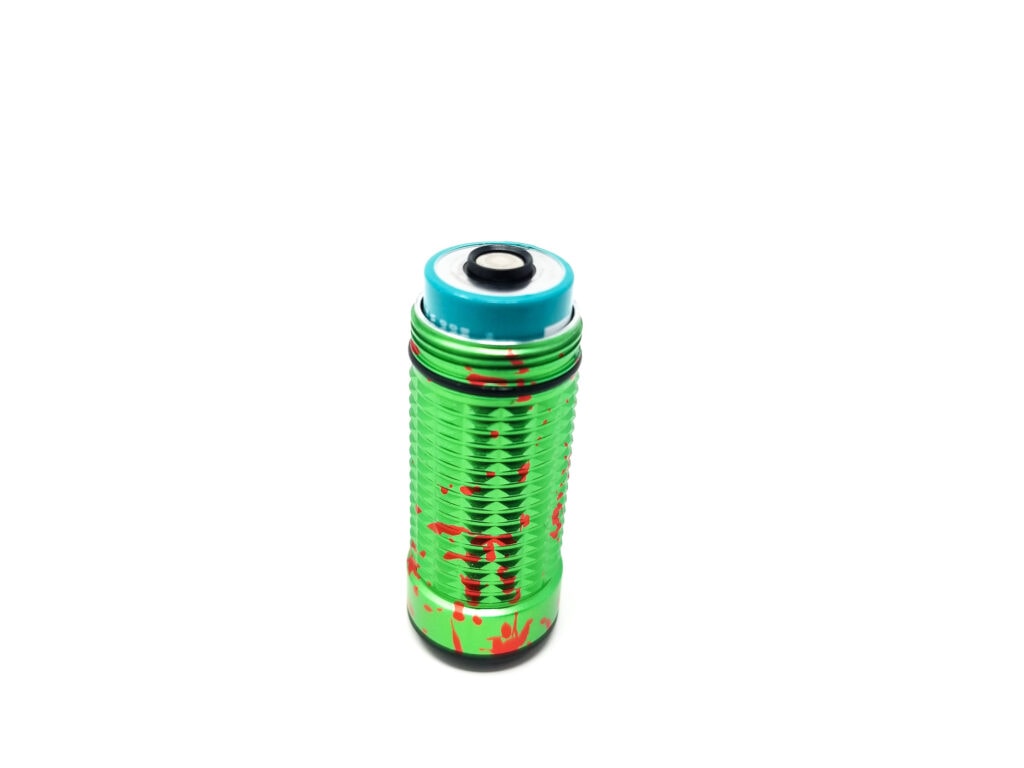
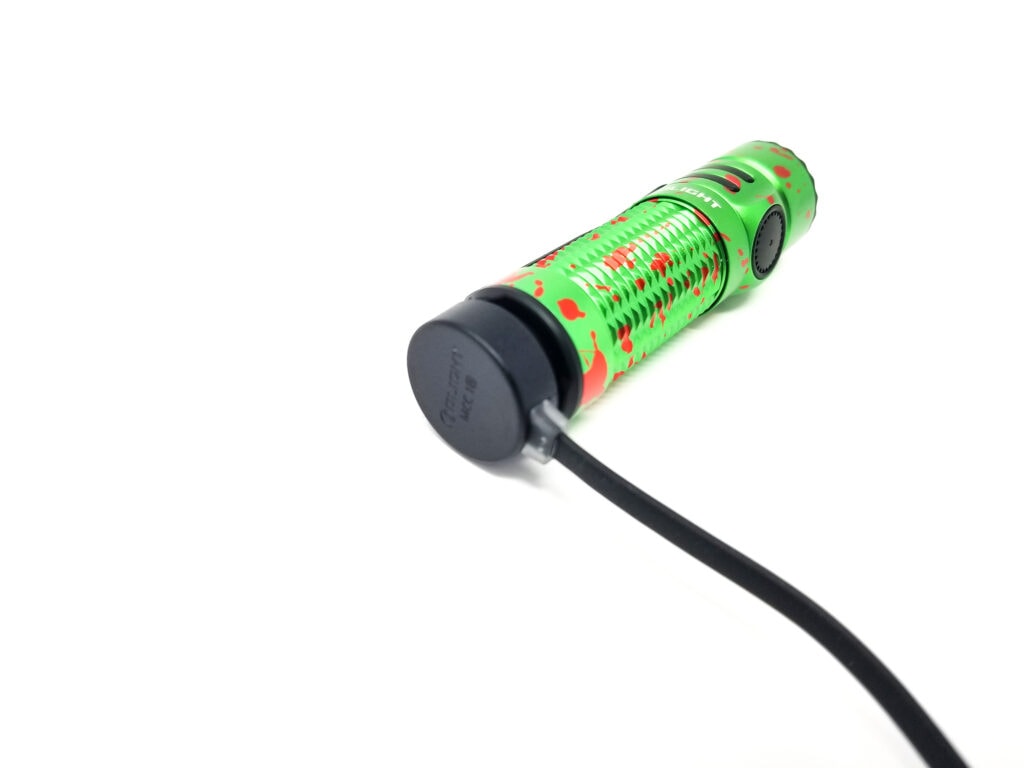
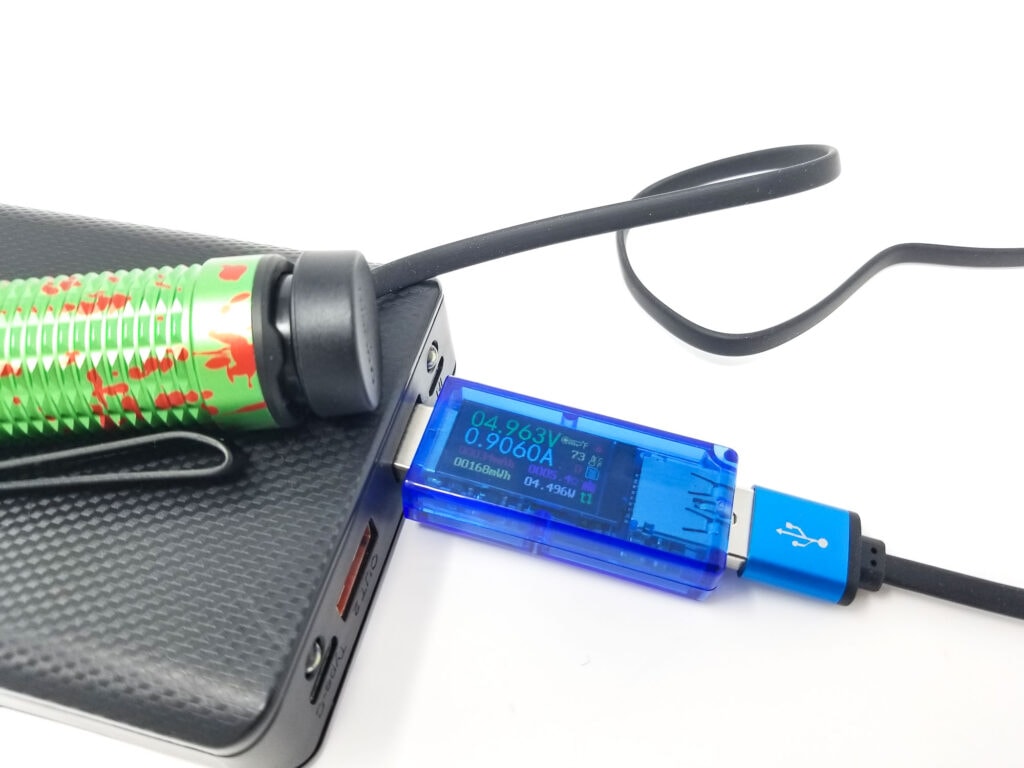
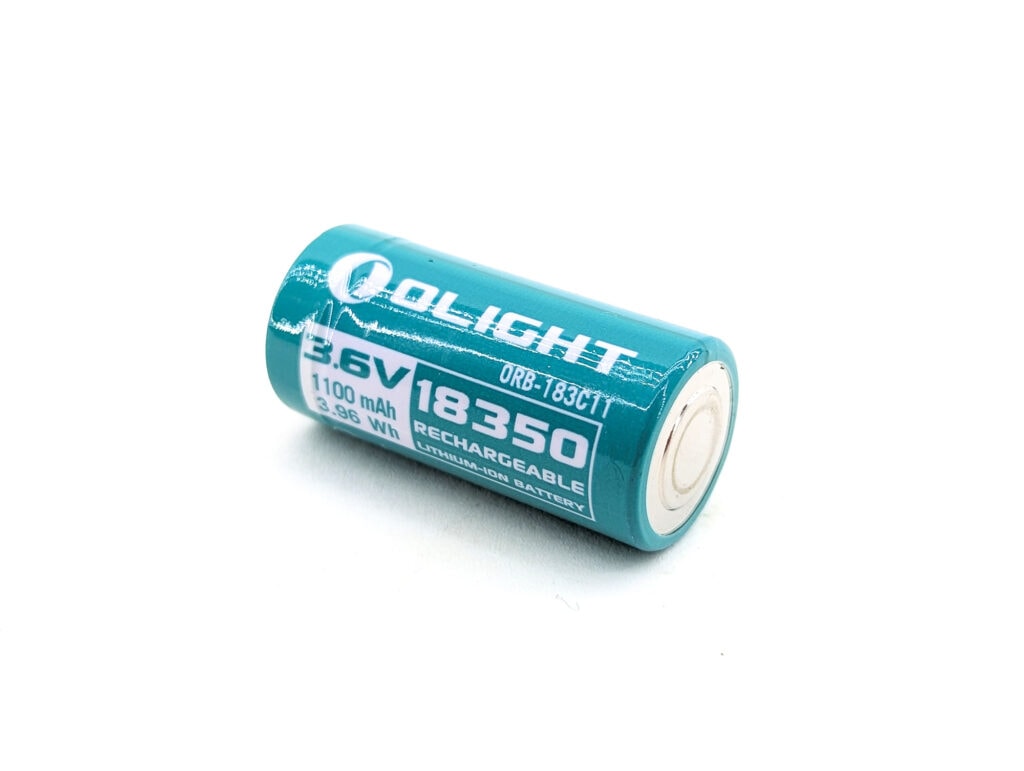
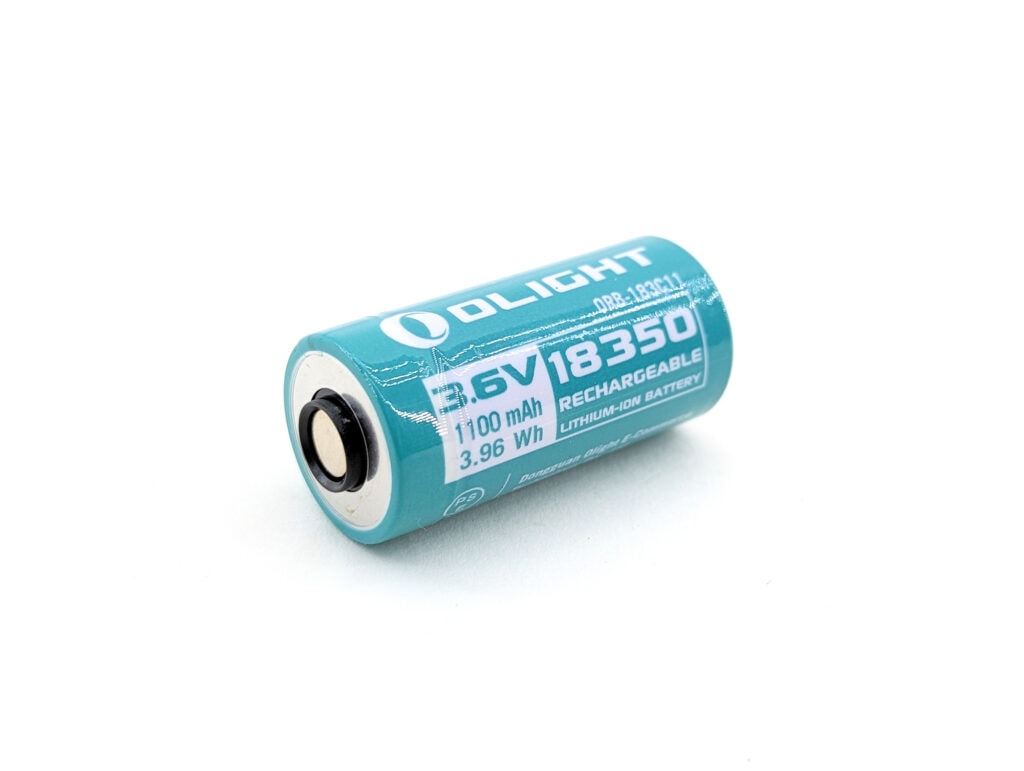
Performance test
Lumen measurements
How Lumens are Measured: Understanding ANSI FL1 Standards How Lumens are Measured: Understanding ANSI FL1 Standards: The ANSI FL1 standards specify that output in lumens should be measured 30 seconds after turning on, as this is the standardized time for measuring brightness according to the industry standard. This is why we focus on this part in our measurements. The ANSI FL1 standards require an ambient temperature of 22 ± 3°C. We record the ambient the ambient temperature to identify potential reasons for any observed discrepancies.Lumens are measured in my 30 cm integrating sphere with a Digi-Sense 20250-00 data logging luxmeter. The sphere has been calibrated with a Convoy S2+ measured to 260 Lumens and the figures are within 10% of actual. I used the fully charged Olight ORB-183C11 battery for the test. No current measurements this time due to the inaccessible current path.
| Mode | Specs | turn on | 30 sec | 10 minutes |
|---|---|---|---|---|
| Moonlight | 0.5 | 0.8 lm | 0.8 lm | – |
| Low | 15 | 13.3 lm | 13 lm | – |
| Med | 60 | 58 lm | 58 lm | – |
| High | 400 | 374 lm | 365 lm | 365 lm |
| Half-Turbo | 600 | 552 lm | 552 lm | 534 lm |
| Turbo | 1200 | 1121 lm | 1077 lm | 356 lm |
Parasitic drain:
- N/A
I’m coming in a bit low for the figures, even for startup which is odd because Olight usually comes in high. Still, pretty good numbers for a small flashlight.
Olight Warrior Nano Battery Life: Runtime graphs
How Runtimes are Measured: Understanding ANSI FL1 Standards About ANSI FL1 runtime standards: The runtime is measured until the light drops to 10% of its initial output (30 seconds after turning on). This does not mean that the flashlight is not usable anymore. The last column shows how long the light actually works till it shuts off. If there is a + symbol, it means that the test was stopped at that particular point, but the light was actually still running. This happens on certain occasions, with certain drivers, firmware, or batteries.Runtimes are measured in my 30 cm integrating sphere with a Digi-Sense 20250-00 data logging luxmeter. The sphere has been calibrated with a Convoy S2+ measured to 260 Lumens and the figures are within 10% of actual. I measure temperature readings with a Digi-Sense 20250-92 data logging thermocouple. The thermocouple probe is affixed to the head with kapton tape, and I used the same 5 second sampling rate as the luxmeter. I used the Olight ORB-183C11 battery for the test and measured High, Half-Turbo, and Turbo modes. I recorded the temperatures for Half-Turbo, and Turbo.
| Mode | Specified runtime | Measured runtime ANSI | Time till shut off |
|---|---|---|---|
| High | 2h 5m | 2h 7m | 2h 8m |
| Half-Turbo | 1h 25m | 1h 24m | 2h 2m |
| Turbo | 1h 20min | 1h 22m | 2h 1m |
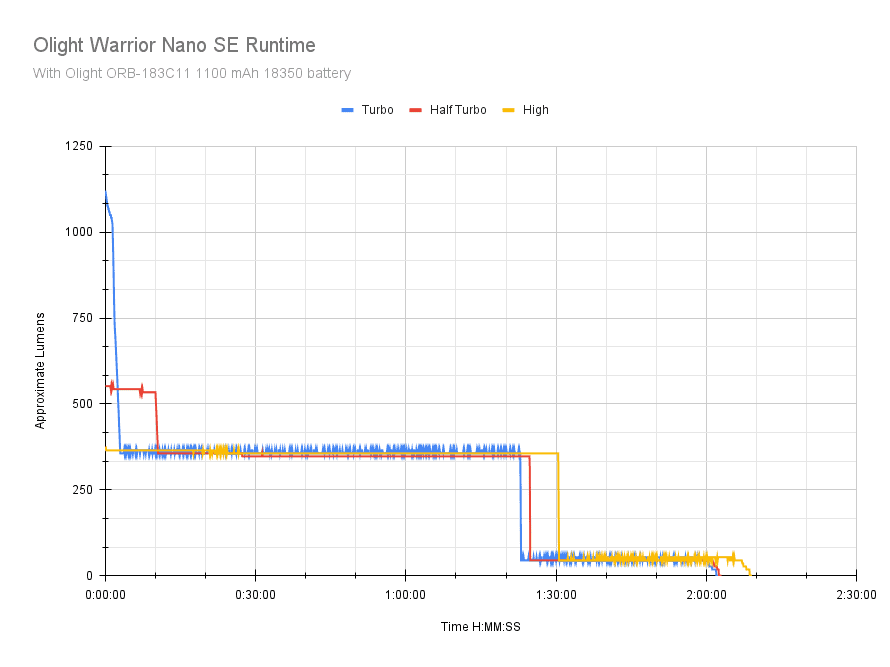
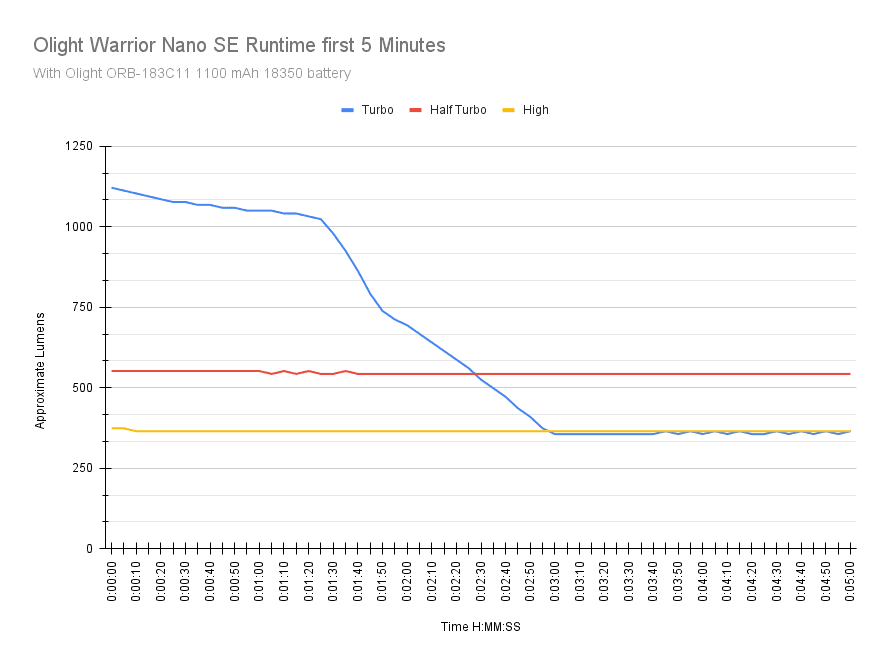
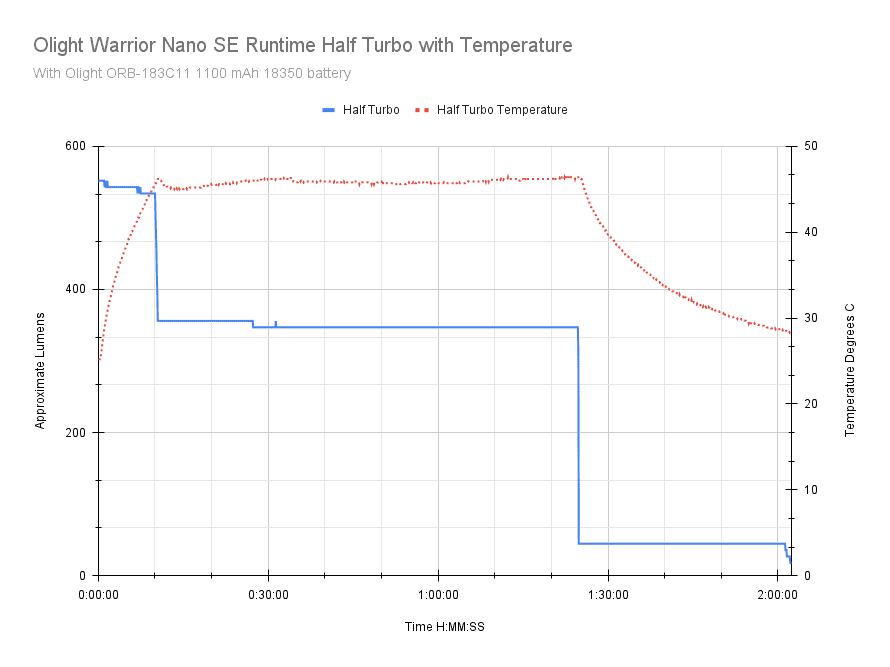
Olight nails the runtime specs for ANSI, as advertised. For a small battery, the runtimes are pretty good, and the driver is very nicely regulated, delivering laminar output without fluctuating or dipping as the battery drains. It was nice to see Turbo mode maintain better than 900 Lumens for 60 seconds, and you still get over 400 Lumens for 2 solid minutes. I didn’t get a temperature reading for Turbo mode due to a technical issue, but I captured the Half Turbo temperatures.
For the data I did get for Turbo, the temperatures were well regulated and the light was never over 52 C and the tube was always cool enough to handle. Half Turbo remained under 50 C the whole runtime. Comparing the Olight Warrior Nano to other lights running 18350s, (except the Odin Mini, which has an 18500 battery), it compares well! I threw in the Sofirn SP10 V3 because it’s bright and tiny like the ‘Nano, but trounces it in runtime and output. Overall, this is a very useful sub compact pocket light. Well done Olight!

Peak beam intensity and beam distance measurements
About Peak beam intensity: Understanding ANSI FL1 Standards About peak beam intensity The calculated value of distance in meters at which the flashlight produces a light intensity of 0.25 lux. (0.25 lux is about the brightness of a full moon shining on an object). This means that the intensity has decreased so much, it becomes difficult to see darker objects, or objects that don’t reflect light. The columns ‘Meters’ and ‘Yards’ use rounded numbers.The beam distance test was conducted using the Uni-t UT383S luxmeter at a distance of 5 meters. The Olight ORB183C11 battery was fully charged for the test. Measurements taken at 30 seconds per ANSI spec.
| Mode | Specs | Candela measured | Meters | Yards |
|---|---|---|---|---|
| Moonlight | N/A | N/A | – | – |
| Low | 65 cd | N/A | – | – |
| Medium | 262 cd | 175 cd | 26 m | 28 yd |
| High | 1577 cd | 1625 cd | 81 m | 88 yd |
| Half-Turbo | 2304 cd | 2525 cd | 100 m | 110 yd |
| Turbo | 4697 cd | 4875 cd | 140 m | 153 yd |
No readings at 5 meters for Moonlight and Low, so no figures for those, but the rest look good.
Beamshots
Camera settings and distance: Samsung Galaxy Note 8 camera set to ISO 200 0.3s and 5000K WB. The fence is 40 meters distant
Beamshots of the following flashlights compared:
- Olight Warrior Nano
- Olight Warrior 3S Special Edition titanium
- Wuben D1
- Manker E14 V
- Olight Odin Mini
Please note that beamshots are mainly intended to showcase the beam pattern and beam quality, rather than overall performance. These images are typically taken directly after activation, and do not fully represent its overall performance. For accurate performance metrics, such as output, beam distance, and runtimes, you need to look at the performance section of this review.

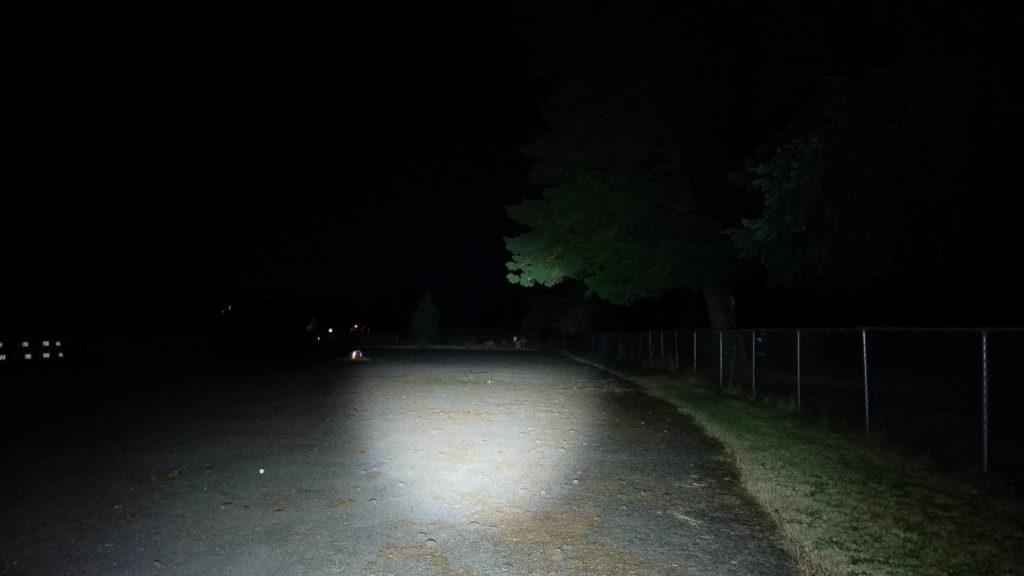
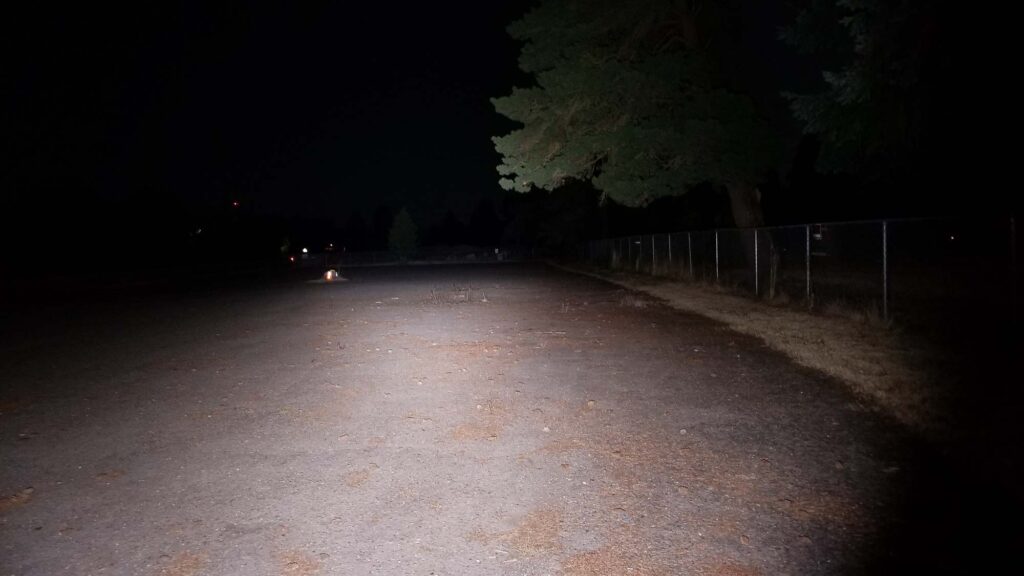
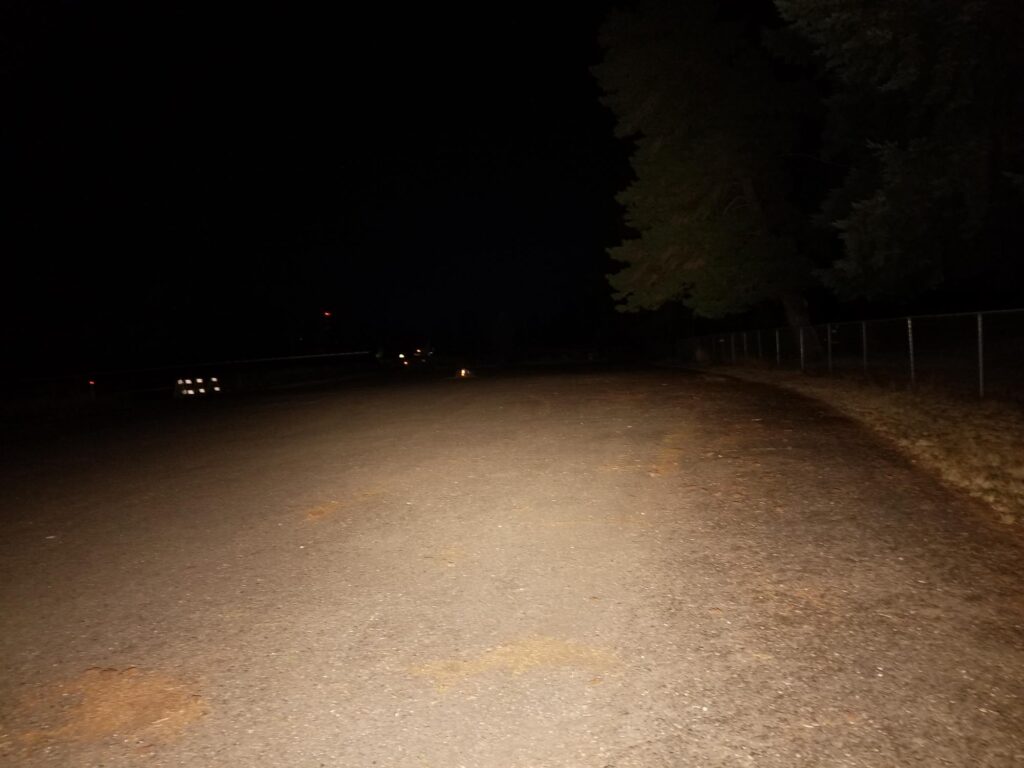

Disclaimer: This flashlight was sent to us for review at no cost by Olight. We have not been paid to review, nor have we been holding back on problems or defects.
Final Verdict
Pros
- Olight quality, fit, and finish
- Fully regulated output
- Unique color
- Great output for the size
- Compact, rides in the pocket and handles great
- Effective dual switch UI with tactical/duty function
Cons
- Proprietary battery and charging system
Explanation on star ratings:
1: Avoid: a match would be a better choice – 2: Poor: significant defect or issues; almost unusable – 3: Average: some defects or issues; but still usable 4: Good: recommended (minor issues) – 5: Great: highly recommended

5 stars: ★★★★★
While our star rating provides a reliable indicator, we encourage you to read the full review to make an informed decision based on your own needs and preferences.
I’ve often thought to myself…”If the Olympics decided to hold a competition for the most consistently-good flashlights, Olight would probably win the gold every time.” Well, there’s currently no Olympic competition for that, but maybe there doesn’t need to be because once again, Olight released a light that impresses in many ways.
All the typical Olight stuff is here in the Warrior Nano: Great build quality, fit, finish, excellent handling manners, an easy to use and intuitive UI, plus great performance to back it up. The Warrior series occupies an important place in Olight’s inventory, and they’ve rounded it out quite nicely with this Warrior Nano. It fits right in between the Warrior Mini and Warrior 3S, and it has more ‘tactical’ appeal than the Baton.
It could be a great backup option clipped to a breast pocket or arm band. I liked the UI and the flexibility of the tail switch to switch between Turbo and Strobe for instant-access. The output is great for such a small light to boot and it handles great, disappearing in my pocket, but not so small that it gets lost in my meat mitt hands and my sausage fingers can’t click the switch.
While I wouldn’t call it a con per-se, if you buy the Warrior Nano, you’re buying into Olight’s proprietary battery and charger system. There’s no getting around it, and that’s a deal-breaker for some folks, but don’t let that deter you because the Olight hits another one out of the park with this one. I think my Lumintop FWAA better start looking for work since it’s getting fired from end table duty. 5 stars for the Warrior Nano.
Buy your Olight Warrior Nano with a discount
Use our exclusive 1lumen discount code to get an extra 10% off anything you order at Olightstore.com (USA). Coupon code: 1lumen
1lumen selects and reviews products personally. We may earn affiliate commissions through our links, which help support our testing.